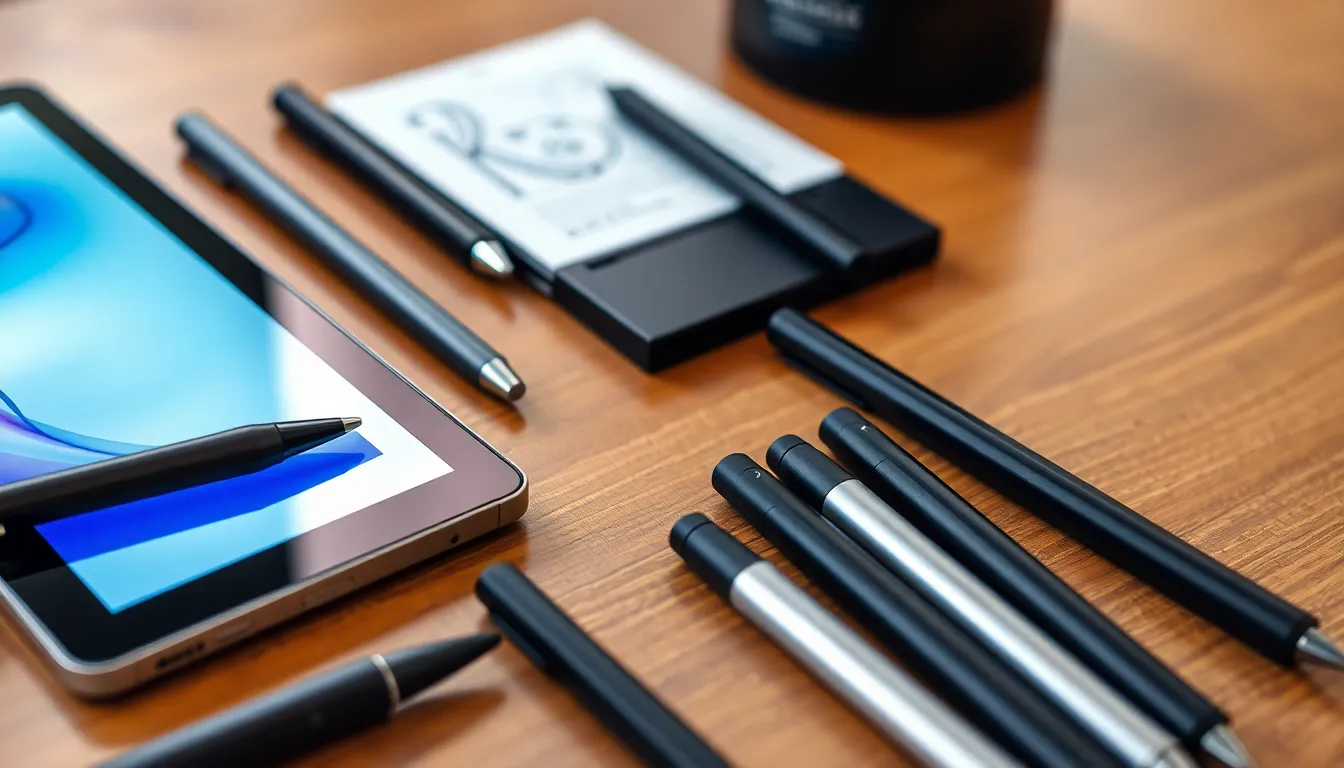Table of Contents
ToggleIn a world where typing reigns supreme, digital pens are here to remind us that the classic art of writing isn’t dead—it’s just evolved. Imagine capturing your thoughts, doodles, and brilliant ideas with a sleek tool that feels as natural as a traditional pen but packs the power of technology. These gadgets are like the Swiss Army knives of the writing world, blending creativity and efficiency in one stylish package.
Overview of Digital Pens
Digital pens serve as a bridge between traditional writing methods and modern technological advances. These devices capture handwritten notes and sketches, converting them into digital formats for seamless access. With various styles and functionalities, digital pens cater to diverse user needs, from students to professionals.
Active pressure sensitivity enables precise line variation, allowing artistic expressions and note-taking more natural. Many models include features like palm rejection, ensuring that users can write comfortably without unwanted interference. Compatibility with various digital platforms enhances versatility, making it easy to integrate into everyday workflows.
Durability stands out as a key feature, with numerous digital pens designed to withstand daily use. Battery life varies among models, with some offering extended usage periods, appealing to those needing reliable performance throughout the day. Connectivity options, including Bluetooth and USB, provide convenient ways to sync with devices.
Digital pens not only enhance productivity but also facilitate creativity. Collaborative features in some models allow multiple users to interact with the same document, fostering teamwork and brainstorming sessions. Users can also personalize settings, optimizing the digital writing experience according to individual preferences.
As the demand for innovative tools grows, digital pens continue to evolve. Brands frequently update their offerings, introducing enhanced technology and user-friendly designs. They combine the tactile joy of writing with the efficiency of digital documentation, satisfying a wide array of consumers.
Types of Digital Pens

Digital pens come in various types, each catering to specific user needs and preferences. Understanding their differences enhances the selection process.
Active vs. Passive Digital Pens
Active digital pens contain built-in technology for enhanced functionality, such as pressure sensitivity and tilt recognition. These features allow for precise line variations and comfortable writing experiences. Passive digital pens rely on the touch sensitivity of compatible screens and generally lack advanced features. While passive options can function on various devices, their capabilities are limited compared to active counterparts. Users seeking versatility and professional-grade precision often prefer active digital pens.
Capacitive vs. Resistive Technology
Capacitive digital pens utilize electrostatic fields, making them suitable for most touchscreen devices. They provide better responsiveness and accuracy, creating a seamless writing experience. In contrast, resistive technology involves pressure-based interaction, requiring more force to create strokes. This technology often appears in older devices and may not deliver the same user-friendly experience. For users prioritizing efficiency and modern interaction, capacitive digital pens remain the ideal choice.
Key Features to Consider
When selecting a digital pen, specific features significantly impact performance and user experience. Understanding these elements could enhance engagement and productivity.
Pressure Sensitivity
Pressure sensitivity plays a crucial role in many digital pens. This feature allows for varying line thickness based on how hard the user presses the pen against the surface. Users often find that higher levels of pressure sensitivity, like 4096 pressure points, create more natural and expressive strokes. Enhanced precision attracts artists and note-takers who desire detail in their work. With such sensitivity, sketching provides an experience akin to traditional drawing. The ability to adjust line weights intuitively adds depth to digital writing.
Battery Life
Battery life is another essential consideration. A longer battery life means users can work without frequent interruptions. Top-performing models can last up to 20 hours on a single charge, making them reliable for extended tasks. Quick charging options also add convenience, allowing users to recharge pens in about 30 minutes for several hours of use. Regular use indicates a preference for pens with substantial battery backup, as frequent charging might hinder productivity. A clear indicator of battery life also helps users manage their workflow effectively.
Ergonomics and Design
Ergonomics and design contribute significantly to comfort and usability. A well-designed pen fits comfortably in hand, reducing strain during prolonged use. Users often prefer pens with a lightweight design, allowing for easy maneuverability. Rubberized grips and balanced weight distribution enhance writing abilities. Furthermore, various styles appeal to diverse aesthetic preferences, improving overall user satisfaction. selecting a digital pen aligns with personal comfort and visual appeal ensures an enjoyable writing experience.
Best Digital Pens on the Market
Digital pens offer a variety of options tailored to meet specific user needs. Various models cater to artists and note-takers, enhancing both creative expression and information capture.
For Artists
Digital pens designed for artists often feature advanced capabilities. Pressure sensitivity allows for nuanced brush strokes, making these pens ideal for detailed work. Models like the Apple Pencil and Wacom Bamboo Ink Plus provide tilt recognition, enabling artists to create with precision. Furthermore, compatibility with professional software such as Adobe Photoshop enhances usability. Ergonomics should also be considered, as designs aimed at comfort lead to longer, more productive sessions. These pens connect effortlessly via Bluetooth, ensuring a smooth workflow on tablets and other devices.
For Note-Taking
Digital pens for note-taking focus on functionality and ease of use. Options such as the Microsoft Surface Pen and Rocketbook Smart Pen stand out for their handwriting recognition features. Users capture handwritten notes that convert into digital text, streamlining organization. Battery life varies, with some models offering up to 20 hours of continuous use, making them reliable for lectures or meetings. Palm rejection technology enhances comfort, allowing natural writing without unintentional input interference. Students and professionals alike benefit from the seamless integration of these pens with popular note-taking applications, facilitating efficient information retention.
Digital pens represent a significant advancement in how people approach writing and creativity. By merging the traditional feel of pen and paper with cutting-edge technology, they cater to a wide range of users. Whether for artists seeking precision or students looking for efficient note-taking solutions, digital pens enhance productivity and engagement.
As technology continues to evolve, these tools are likely to become even more sophisticated. With various options available, users can find the perfect digital pen that suits their unique needs. Embracing this innovative writing solution can lead to a more enjoyable and productive experience, making it an essential tool in today’s digital landscape.




